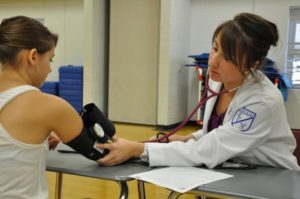 Are you a parent with a child who has Postural Orthostatic Tachycardia Syndrome? It’s important to work with your child’s school medical personnel to make sure they’re aware of your child’s condition and can assist them during emergencies. Below is a letter you can print and bring to the school’s nurse to help them better understand the disease and what course of action to take in case of emergencies.
Are you a parent with a child who has Postural Orthostatic Tachycardia Syndrome? It’s important to work with your child’s school medical personnel to make sure they’re aware of your child’s condition and can assist them during emergencies. Below is a letter you can print and bring to the school’s nurse to help them better understand the disease and what course of action to take in case of emergencies.
_____________________
Attention School Medical Official: You currently have a student under your care who has been diagnosed with Postural Orthostatic Tachycardia Syndrome.
ABOUT POTS: POTS is a syndrome that develops in patients with dysautonomia—the dysfunction of the autonomic nervous system. Because the autonomic nervous system controls many bodily functions, there are a multitude of symptoms that can fatigue and disorient a patient.
Some of the POTS symptoms include:
- Tachycardia and racing heart
- High or low blood pressure
- Change in blood pressure and pulse upon changing of position
- Vertigo/Dizziness
- Fatigue
- Nausea and gastric motility issues
- Dehydration and hypervolemia
- Malnourishment
- Migraines
- Neck and Back Pain
- Joint Pain
- Visual Disturbances
- Fainting
- Blacking Out
- “Brain Fog”
- Heat Intolerance
Dehydration: You should be on the lookout for signs of dehydration as POTS patients can become quickly and easily dehydrated and they may not be able to sustain hydration orally. If they do seem dehydrated they should be given something salty to eat and drink (a sports drink.) POTS patients are advised to avoid prolonged exposure to heat and direct sunlight. They should never be without access to hydration when doing physical activity.
Low/High Blood Pressure/High Pulse: If a patient has too high a pulse they should recline flat and wait until their pressure returns to normal. If it does not return to normal (after a period of time) they may need access to intravenous hydration.
Fainting: Patients with POTS may “black out” or experience fainting episodes. If the patient is experiencing umanageable tachycardia or syncope, they should not be returned to class where they may injure themselves during a fall. If rest and fluids does not resolve the issue, they should be sent home.
Treatment: Patients may be put on a regimen of beta blockers or calcium channel blockers to suppress their tachycardia. Please make sure the child has access to their medication as needed. Patients may also need regular IV’s to stabilize hydration. If the child is experiencing migraines, dry skin and mouth, is dizzy or incoherent, they may need to be taken to an emergency room to get fluids.
What does an IV do that drinking regular fluids can’t?
By using one liter of IV saline, we safely expand the circulating blood volume without affecting the sodium and chloride (“electrolyte”) concentrations. The circulating blood volume of a normal sized individual is approximately 5 liters so we are increasing it by about 20%. This can significantly help with supporting upright blood pressure and slowing the reflex tachycardia.
For more information on Dysautonomia and Postural Orthostatic Tachycardia Syndrome visit www.santamariamedicine.com
_________________________